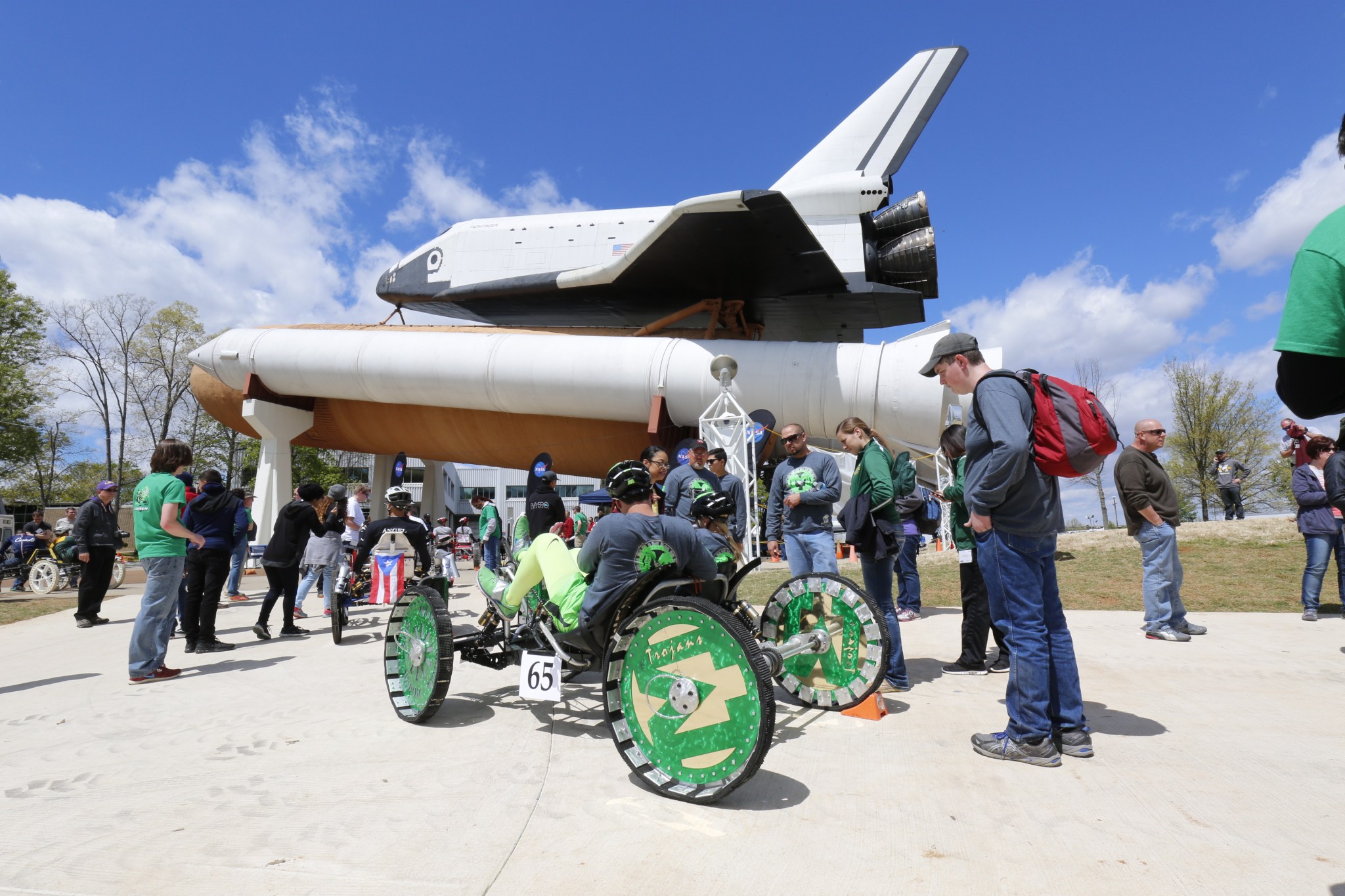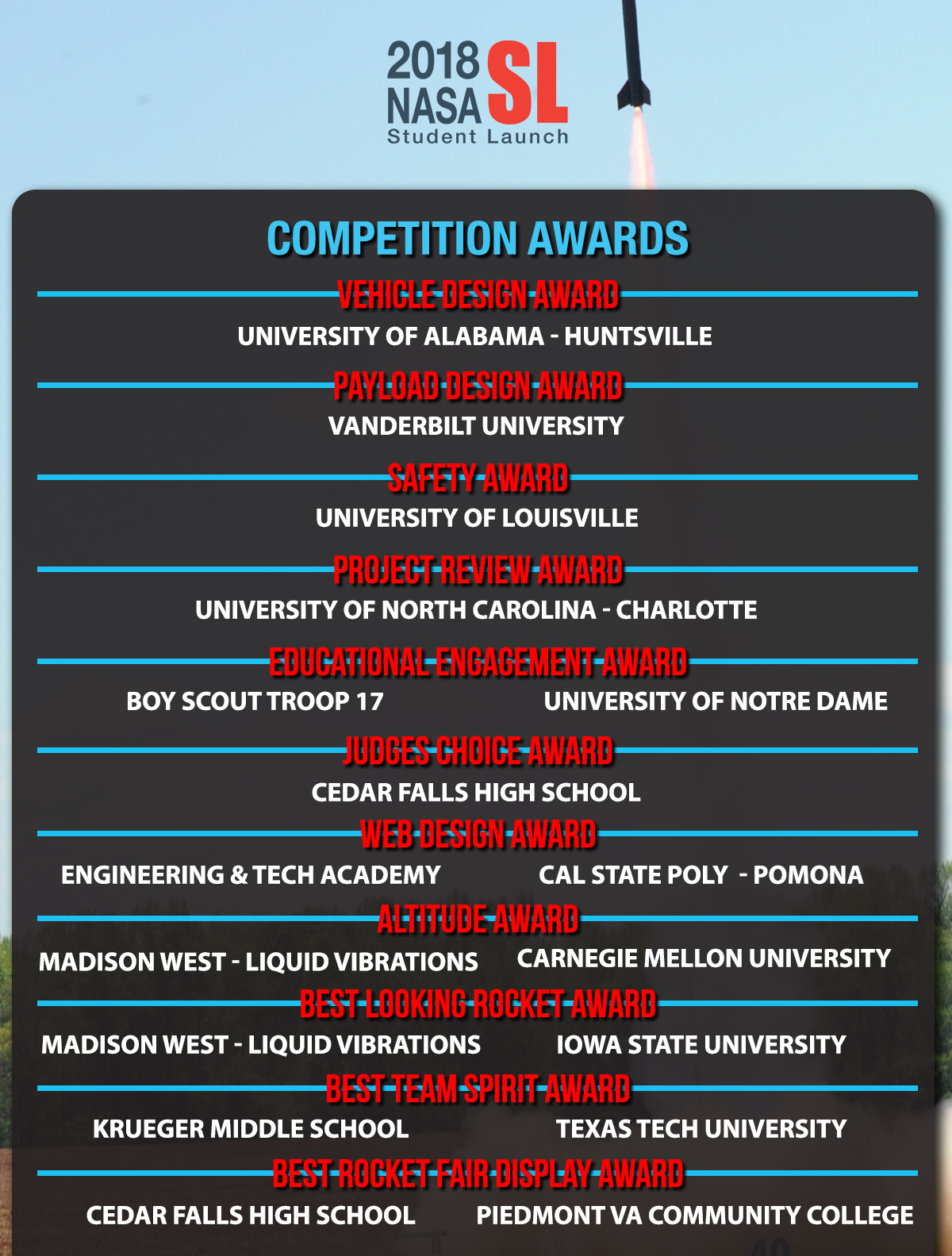In This Week’s Star
- Students to Compete in NASA’s Human Exploration Rover Challenge
- Marshall Engineer Takes Safety to Another Level on Commercial Flight
- NASA Announces Preliminary Award Winners of 2018 Student Launch
- NASA Astronaut Randy Bresnik, ESA Astronaut Paolo Nespoli Visit Marshall
- SpaceX Dragon Arrives at Space Station with Material Samples from Marshall and New Facility for Testing Them
- Student Launch Teams Visited by Out-of-This-World Guests
- NASA Awards Contract for Logistics Support Services
- This Week in NASA History: STS-37 Lands – April 11, 1991
- A Study by NASA’s Chandra X-ray Observatory Highlighted on ‘This Week @NASA’
- Obituaries
Students to Compete in NASA’s Human Exploration Rover Challenge
By Brian C. Massey
Nearly 100 teams are expected to participate in NASA’s Human Exploration Rover Challenge April 13-14, at the U.S. Space & Rocket Center in Huntsville, including teams from 23 states, the District of Columbia, Puerto Rico, and several countries, such as Brazil, Germany, India and Mexico.
The competition, hosted by NASA’s Marshall Space Flight Center, challenges high school and college teams to design, build and test human-powered roving vehicles inspired by the Apollo lunar missions and future exploration missions to the Moon, Mars and beyond.
Entering its 24th year, the rules and challenges for Rover Challenge have been redesigned in 2018 to better simulate a real exploration mission. Once focused on the fastest time, this year’s competition will challenge teams to complete 14 obstacles and five tasks throughout the half-mile course, with a six-minute supply of “virtual” oxygen.
The obstacles will simulate the terrain found throughout the solar system, and the tasks will challenge teams to collect and return samples, take photographs and plant a flag. Teams must decide which tasks and obstacles to attempt or bypass before their clock expires.
The competition, managed by Marshall’s Academic Affairs Office, is one of many NASA initiatives to encourage students to study the STEM fields of science, technology, engineering and mathematics, and to inspire the next generation of explorers.
The two-day event and awards ceremony will be broadcast live on a variety of streaming platforms, including Facebook Live, Periscope and Ustream.
Massey, an ASRC Federal/Analytical Services employee, supports the Office of Strategic Analysis & Communications.
Marshall Engineer Takes Safety to Another Level on Commercial Flight
By Jonathan Deal
At NASA, safety is part of everyday conversations and is reflected in the attitudes and behaviors of the workforce, creating a strong safety culture.
It should be no surprise then, that an engineer from NASA’s Marshall Space Flight Center demonstrated that safety-first mentality on a commercial flight out of Huntsville in January. Shortly after take-off, Rumaasha Maasha, an aerospace engineer in Marshall’s Spacecraft & Vehicle Systems Department, spotted a fuel leak during his morning flight on a work trip to Denver.
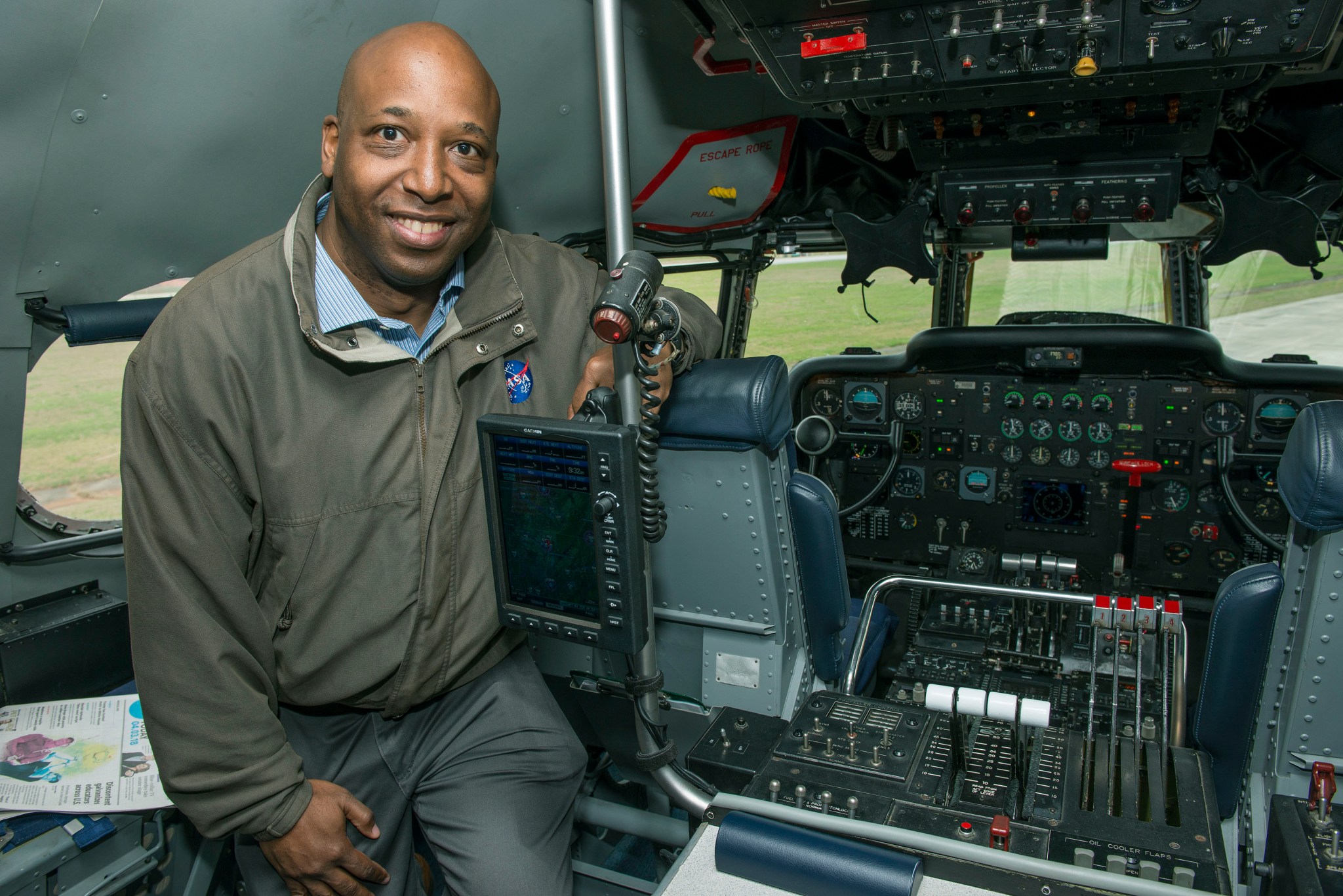
“Normally, if it’s a humid day, you’ll see vortices, or circular patterns of rotating air, off the wing,” Maasha said. “About 1,000 feet off the ground, I started seeing something white and thought, ‘maybe we’re just hitting some humidity.’ Well, then we banked to turn cross-wind and it was still doing it, and that’s when I knew something was up. I looked closer and immediately realized that we were losing fluid.”
Seeing the spewing white fuel outside his window near the wing, Maasha identified the problem as a malfunctioning vent valve. He also knew that as the plane increased velocity at higher altitudes, the Venturi effect allowed by the faulty vent valve would increase suction on the fuel tank, accelerating the leak.
“I quietly motioned to the flight attendant to come over and fortunately she was very attentive,” he said. “She called the crew and the key thing is that she did this as we were still climbing out. Within a minute or two, they reduced speed and leveled off. The fuel leak diminished immediately when they slowed down.”
Thanks to Maasha’s quick thinking and decisive action in alerting the crew, the plane was immediately rerouted to return to Huntsville International Airport. After a few groans and moans from passengers when learning the plane was turning around, word quickly spread of Maasha’s actions and he was lauded for his heroic efforts by those seated nearby. While being a 14-year NASA veteran had a lot do with his safety-first attitude, Maasha’s history with airplanes goes back much farther.
His love for aviation began as child living near an airport in Monrovia, Liberia, where his parents were professors at a university. From age 4 to 13, Maasha would visit the airport after school with his dad, watching planes take off, talking with pilots and even getting to sit in a cockpit. It was during that time spent with his dad, an engineer and geophysics professor, that Maasha developed his obsession with aviation.
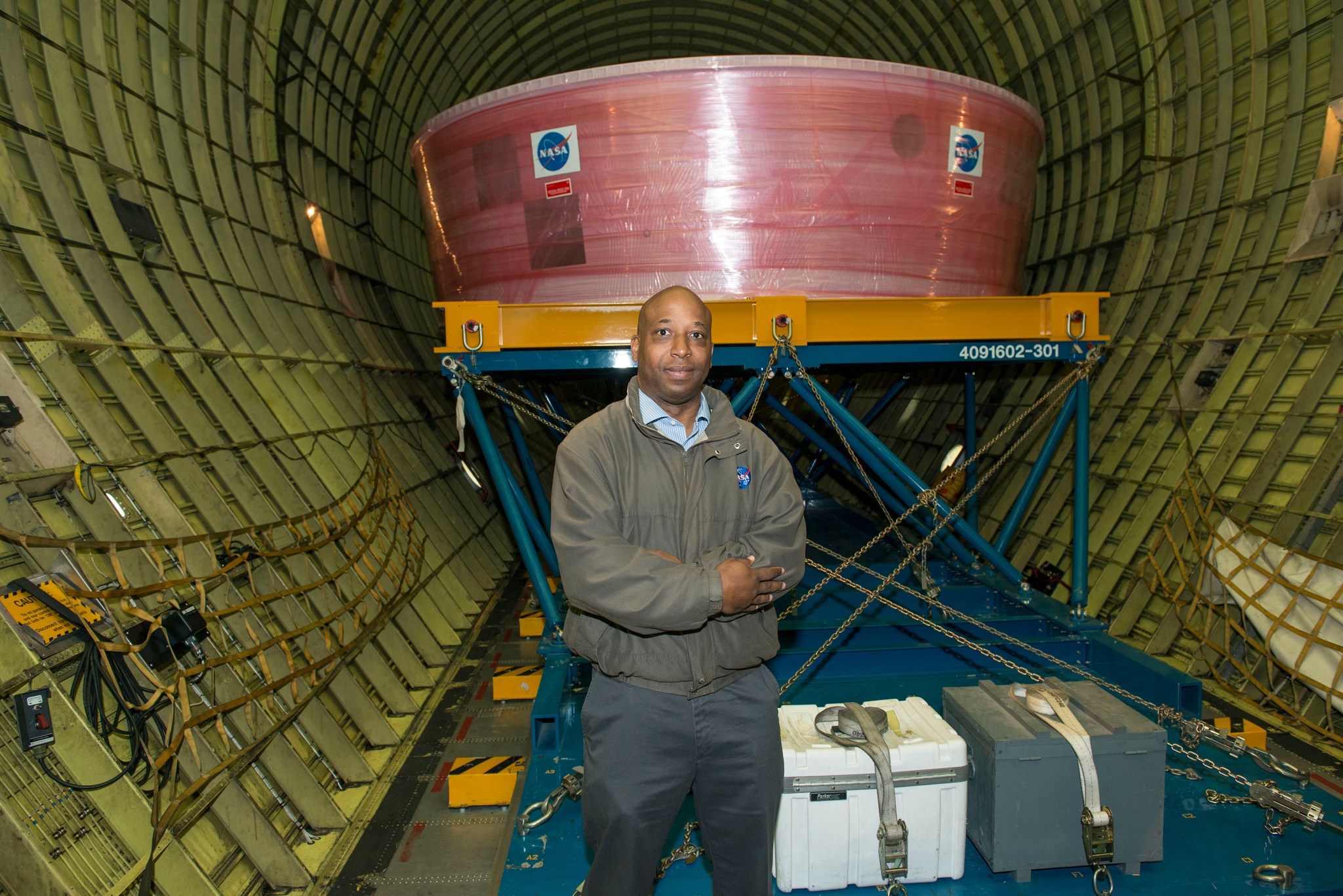
He followed his dream, enrolling in Columbia University in New York — at age 15 — to earn a bachelor’s degree in engineering mechanics, followed by a master’s degree in aerospace engineering from Georgia Institute of Technology in Atlanta. Unable to immediately find a job in his field, Maasha went back to what he knew best — airplanes. He took a job as a refueler for Delta Airlines and later worked as a 747 cargo loadmaster for another airline.
In addition to a private pilot’s license he obtained a few years earlier, he completed an associates in aviation maintenance technology, becoming an FAA-certified airframe & powerplant mechanic. After a few years working for a university research center in Georgia, he was offered a position in 2002 as a contractor supporting Marshall’s Structural Dynamics Branch, and became a civil servant in 2004.
“My background was more with aircraft, so for launch vehicles, there is obviously a different environment and different flight pattern,” Maasha said. “But it’s very much the same as far as understanding the dynamics of the rocket because we try to make them as efficient as possible. So, it’s even more important to pay attention to dynamics issues and acoustics as far as a rocket compared to an aircraft.”
When he’s not safeguarding his fellow flight passengers, Maasha is ensuring the safety of NASA’s Space Launch System — the agency’s new, deep-space rocket that will enable astronauts to begin their journey to explore destinations far into the solar system. At Marshall, he specializes in structural dynamics, specifically with loads analysis, modal and vibro-acoustics testing. Recently, Maasha was part of the team that performed modal testing on the Integrated Spacecraft & Payload Element Structural Test Article stack — precursor testing for the Orion stage adapter flight hardware recently transported to NASA’s Kennedy Space Center.
“Looking back, I guess I had the perfect sets of circumstances to recognize the issue that day,” he said. “Since I was a kid, I’ve always tried to sit in a window seat near the wing. That’s not the first time I’ve noticed something. I’m sure it won’t be the last.”
Whether it’s passengers flying commercial or the astronauts that will eventually fly on Orion, it’s NASA engineers like Rumaasha Maasha who ensure they travel safely.
Deal, an ASRC Federal/Analytical Services employee and Marshall Star Editor, supports the Office of Strategic Analysis & Communications.
NASA Announces Preliminary Award Winners of 2018 Student Launch
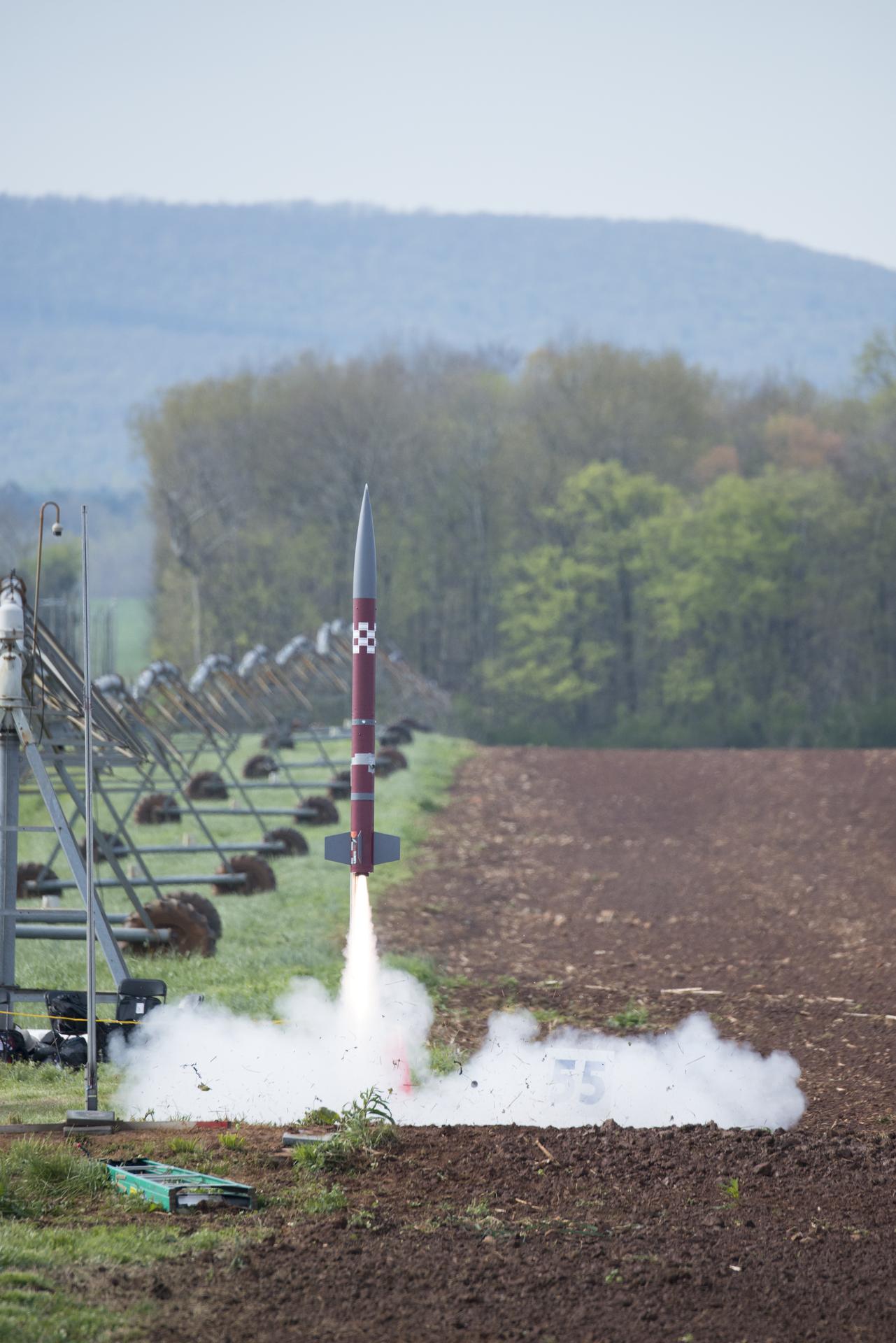
On April 8, the usually quiet fields of Bragg Farms in North Alabama transformed into a small spaceport as nearly 50 teams from 23 states launched their student-built rockets in the annual Student Launch competition, hosted by NASA’s Marshall Space Flight Center.
Preliminary winners were announced at an awards ceremony April 7, sponsored and hosted by Orbital ATK’s Propulsion Systems Division of Promontory, Utah, at the U.S. Space & Rocket Center. The altitude award winners were determined April 8.
Participating in the Student Launch challenge, student teams demonstrated advanced aerospace and engineering skills as they launched their rockets to an altitude of 1 mile, deployed an automated parachute system and landed the rocket safely for reuse.
The altitude award was given to the team in each division that came closest to 1 mile — 5,280 feet. Rookie team Carnegie Mellon University from Pittsburgh, Pennsylvania, claimed the prize in the college division with an altitude of 5,367 feet; and the Madison West High School Team Liquid Vibrations from Madison, Wisconsin, secured victory in the middle/high school division with an altitude of 5,271 feet.
The event was the culmination of eight months of work for students, during which the teams built and tested their rockets and completed a series of technical reviews mirroring criteria in NASA’s engineering design lifecycle and safety protocol.
Now in its 18th year, Student Launch included a visit from NASA astronaut Randy Bresnik and European Space Agency astronaut Paolo Nespoli, members of the International Space Station’s Expedition 52/53 crew; a behind-the-scenes tour of Marshall facilities; and a rocket fair, where students showcased their rocket designs to NASA team members, Orbital ATK and the public.
Marshall’s Academic Affairs Office manages Student Launch, to further NASA’s major education goal of attracting and encouraging students to pursue degrees and careers in the STEM fields of science, technology, engineering and mathematics. NASA’s Office of Education and Human Exploration and Operations Mission Directorate, as well as Orbital ATK’s Propulsion Systems Division and the Huntsville chapter of the National Space Club, provide funding and leadership for the initiative.
For a full list of winners, click here.
The overall winners of Student Launch will be announced in early May, as the final calculations are still under review for accuracy. This will include the first- through third-place teams, as well as the rookie award winner, with the first-place winner receiving a $5,000 prize from sponsor Orbital ATK and the second-place winner receiving a $2,500 prize from the National Space Club.
For more information about NASA’s Student Launch, click here. To watch archived launch-day footage, visit NASA’s Student Launch Facebook account.
NASA Astronaut Randy Bresnik, ESA Astronaut Paolo Nespoli Visit Marshall
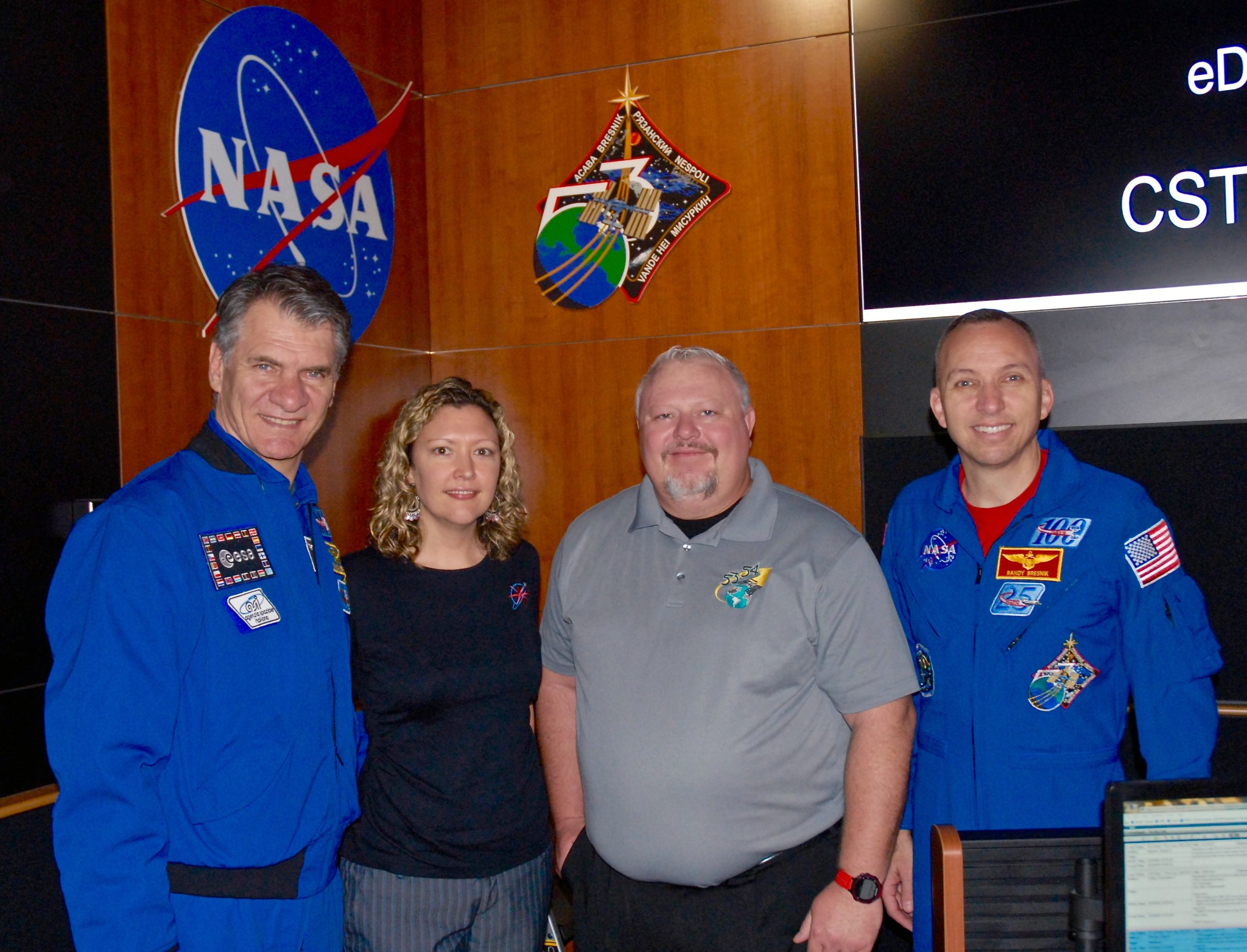
Expedition 53 crewmembers attend a plaque hanging ceremony April 6 inside the Payload Operations Integration Center at NASA’s Marshall Space Flight Center recognizing the POIC team’s efforts supporting science investigations on the International Space Station. NASA astronaut Randy Bresnik, right, and European Space Agency astronaut Paolo Nespoli, left, pose with Stephanie Dudley, Expedition 53 payload operations manager, and Damon Self, lead operations controller for Expedition 53. Bresnik and Nespoli lived and worked on the space station from July to December 2017 as part of the Expedition 52 and 53 crews. (NASA/MSFC/Tim Hanby)
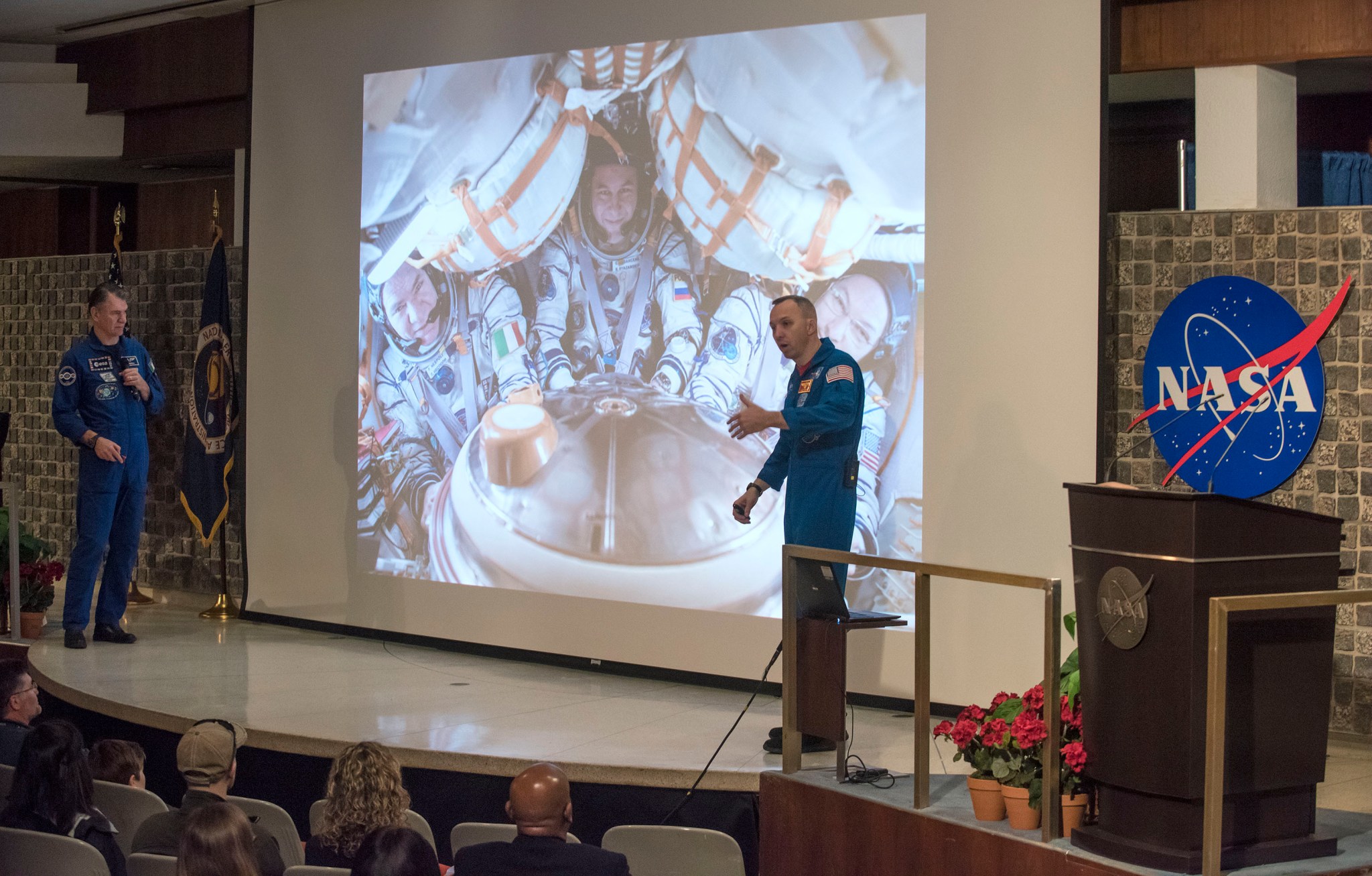
NASA astronaut Randy Bresnik, right, and ESA astronaut Paolo Nespoli speak to Marshall team members April 6 in Building 4200’s Morris Auditorium. Bresnik and Nespoli, who lived and worked on the International Space Station from July to December 2017, shared highlights as members of the Expedition 52 and 53 crews, and took questions from the Marshall workforce. (NASA/MSFC/Charles Beason)
SpaceX Dragon Arrives at Space Station with Material Samples from Marshall and New Facility for Testing Them
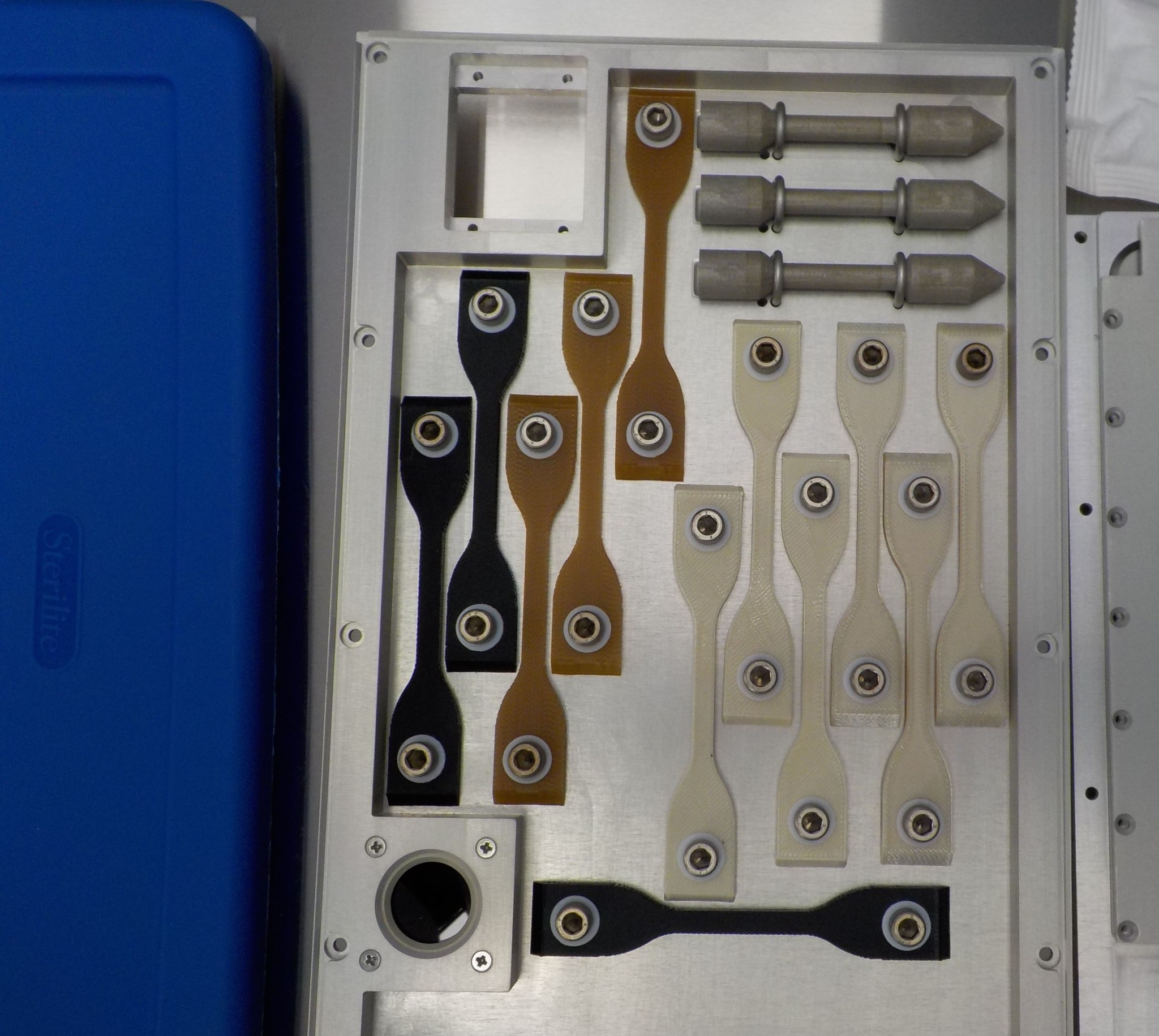
On April 4, the SpaceX Dragon that launched April 2 arrived at the International Space Station to deliver more than 5,800 pounds of research investigations, cargo and supplies, including NASA’s Materials International Space Station Experiment. This is the ninth MISSE mission in the program’s long history of testing material samples in space.
Also on board was the new MISSE flight facility hardware developed by Alpha Space Test and Research Alliance of Houston. The flight facility holds several new polymers and other material samples from both NASA researchers and commercial organizations.
NASA’s material samples included on MISSE-9 have a variety of research objectives. The material samples currently on the flight facility will remain on the station for one year of testing as part of MISSE-9. This long-duration exposure to the harsh space environment will enable researchers to evaluate the potential performance of their materials in future long-term space applications.
NASA’s Marshall Space Flight Center was represented on MISSE-9, with researchers studying several different additively manufactured or 3-D printed materials in an effort to further the advancement of space-based manufacturing.
“We are flying metallic and non-metallic samples, to cover what might be made on the ground or 3-D printed on the space station,” said Miria Finckenor, principal investigator and a materials engineer at Marshall. “During a long-duration mission, an astronaut may need to print a replacement part, and we want to make sure that part will hold up in space.”
In addition to the 3-D printed samples, Finckenor’s team sent sensors on MISSE-9 to measure how much ultraviolet radiation the flight facility is receiving.
“The long series of MISSE flights leading up to MISSE-9 has been an unparalleled success for on-orbit material science,” said Alpha Space President and CEO Mark Gittleman. “MISSE-9 continues that tradition and also represents a huge step forward in space science in several important ways.”
Gittleman explained that the flight facility will remain permanently installed on the exterior of the orbiting laboratory. “The mass and cost to launch science experiments and investigations will be reduced to only the incremental mass and cost of launching experiment trays and carriers, rather than an entire facility,” Gittleman said.
He also noted that experiments requiring very long exposure can remain in place on the flight facility not just for weeks or months, but for years if required.
In addition, Gittleman said, Alpha Space and NASA have entered into a commercialization agreement for the flight facility that reserves a portion of its capacity for NASA samples while leaving the remaining space open for use as a commercial facility.
“This makes space available to all scientists through contracts with Alpha Space,” said Gittleman. “Alpha Space provides turn-key, fixed price integration services that make getting science to the station as simple and inexpensive as possible, and we think that opens up the benefits of space science to a whole new audience.”
The MISSE flight facility was co-funded by the International Space Station Program Office and Alpha Space Test and Research Alliance, LLC. Under its cooperative agreement, Alpha Space manages the flight missions. MISSE supports both NASA and commercial flight experiments and investigations, and NASA’s Space Technology Mission Directorate selects the NASA investigations through NASA’s Flight Opportunities program.
Student Launch Teams Visited by Out-of-This-World Guests
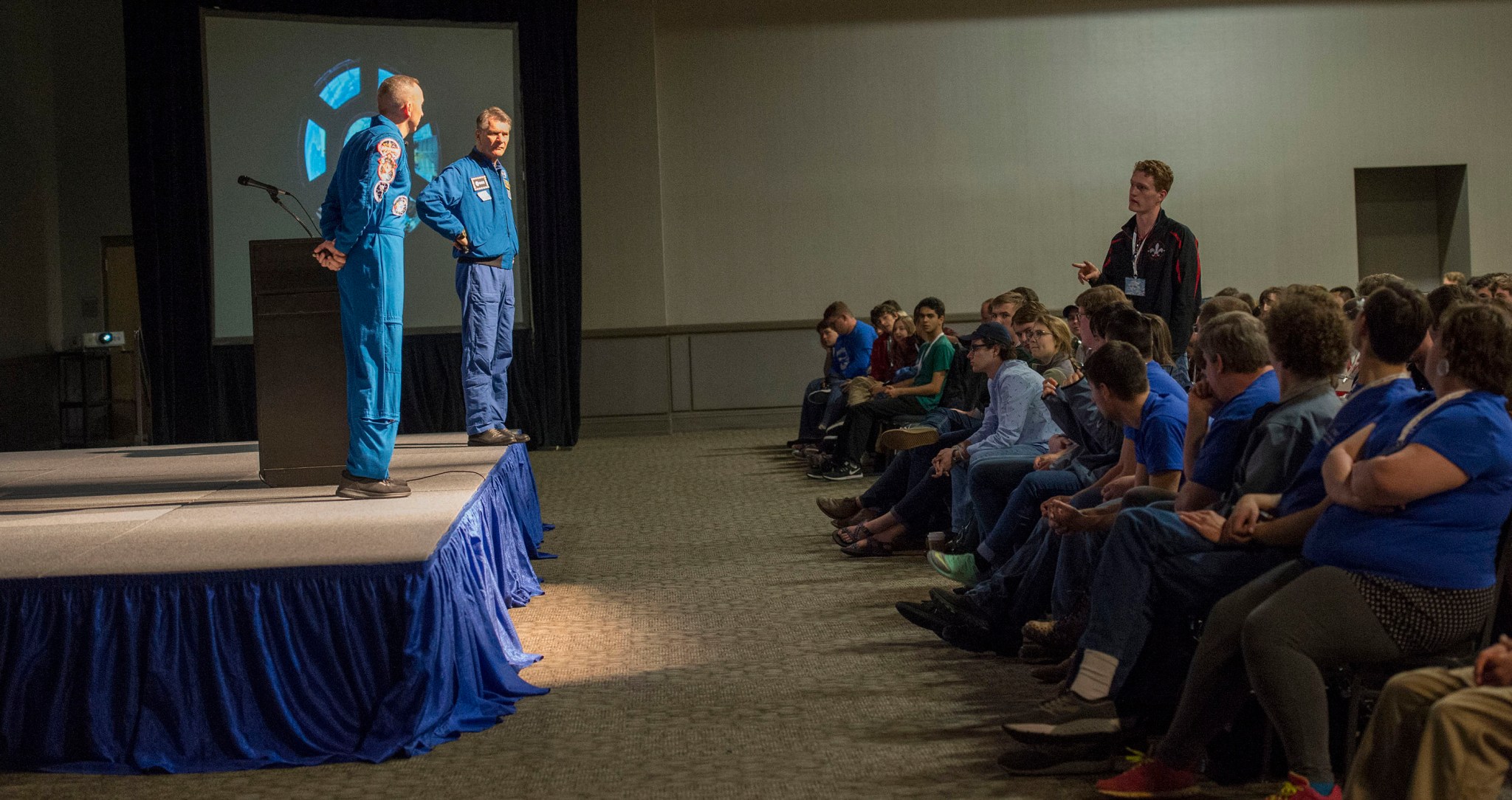
While in Huntsville visiting NASA’s Marshall Space Flight Center, NASA astronaut Randy Bresnik, left, and European Space Agency astronaut Paolo Nespoli, crew members of Expedition 52-53 to the International Space Station, stopped by the Von Braun Center April 5 to speak with hundreds of students participating in NASA’s Student Launch rocket competition. Both astronauts shared highlights from their recent six-month mission living and working aboard the space station and answered questions from several students. The Student Launch competition was held April 8 at Bragg Farms in Toney, Alabama. (NASA/MSFC/Emmett Given)
NASA Awards Contract for Logistics Support Services
NASA has awarded a contract to L&M Technologies Inc. of Albuquerque, New Mexico, to provide logistics support services at the agency’s Marshall Space Flight Center.
The Marshall Logistics Support Services is a performance-based, firm-fixed-price, indefinite-delivery, indefinite-quantity contract that has a potential mission services value of $28.2 million and a maximum IDIQ potential value of $60.5 million. The contract begins May 1 with a one-year base period followed by four one-year options.
Under the contract, L&M Technologies Inc. will be responsible for providing services for equipment; motor pool and transportation; flight hardware support operations; shipping and receiving; mail; moves and furniture; property disposal and material, property and warehouse management.
This Week in NASA History: STS-37 Lands – April 11, 1991
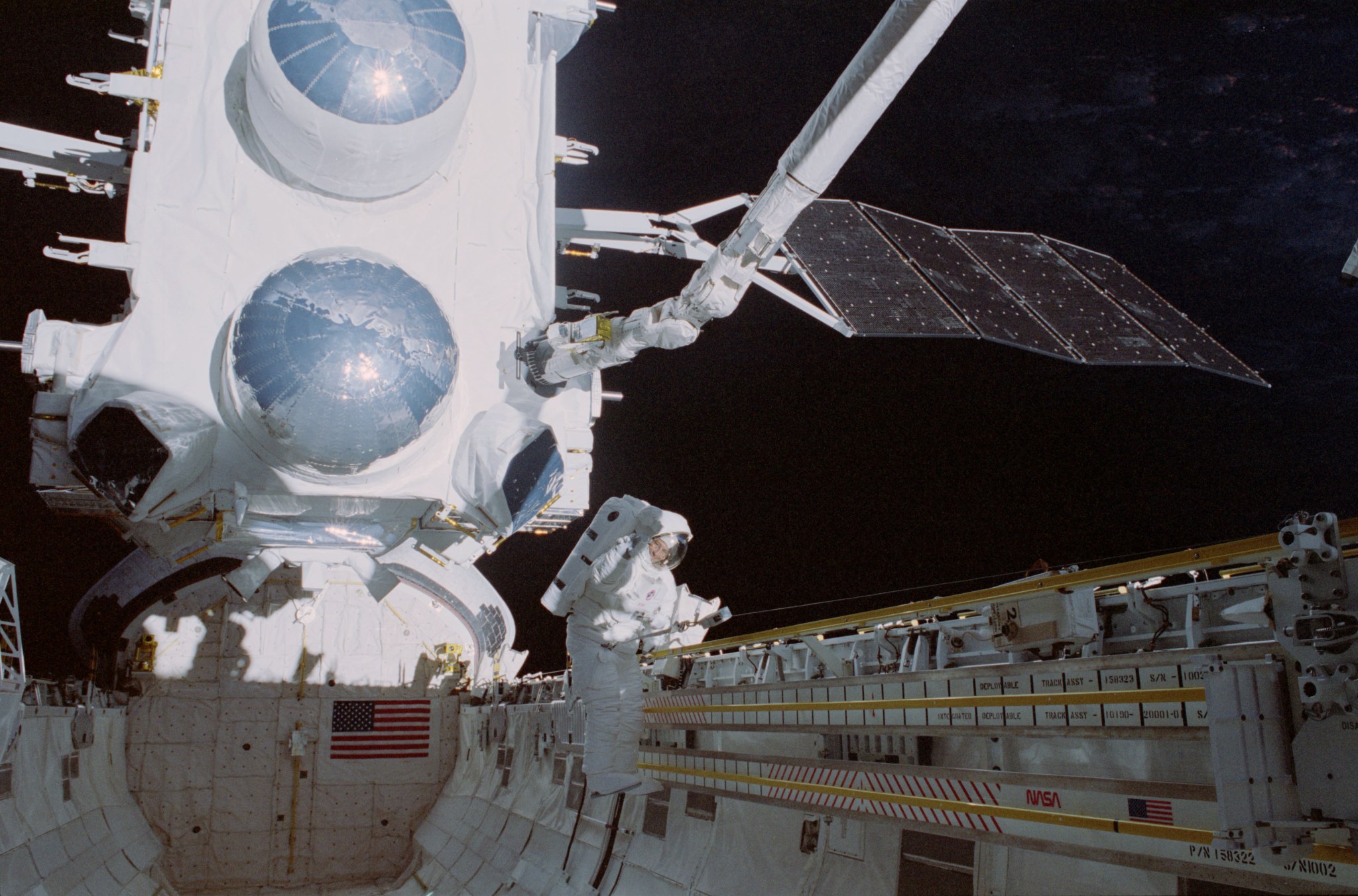
This week in 1991, space shuttle Atlantis, mission STS-37, landed at Edwards Air Force Base in California following a successful five-day mission. The primary payload — the Compton Gamma Ray Observatory — was deployed on the third day of its mission, following an unscheduled spacewalk to manually deploy the observatory’s high-gain antenna. NASA’s Marshall Space Flight Center designed and managed the Burst and Transient Source Experiment, one of four major science instruments aboard the Compton. Compton was part of the Great Observatories program, which also included the Hubble Space Telescope, the Spitzer Space Telescope and the Chandra X-ray Observatory. Today, Marshall manages the Chandra program for NASA’s Science Mission Directorate in Washington. The NASA History Program is responsible for generating, disseminating and preserving NASA’s remarkable history and providing a comprehensive understanding of the institutional, cultural, social, political, economic, technological and scientific aspects of NASA’s activities in aeronautics and space. For more pictures like this one and to connect to NASA’s history, visit the Marshall History Program’s webpage. (NASA)
A Study by NASA’s Chandra X-ray Observatory Highlighted on ‘This Week @NASA’
A new study by NASA’s Chandra X-ray Observatory is featured in “This Week @NASA,” a weekly video program broadcast nationwide on NASA-TV and posted online.
Chandra has been used to study a cosmic cold front located in the Perseus galaxy cluster that extends for about 2 million light years, or about 10 billion billion miles. The cold front consists of a “cool” band of gas that is about 30 million degrees, moving through hot gas that is about 80 million degrees. It formed about 5 billion years ago and has been traveling at speeds of about 300,000 miles per hour ever since.
NASA’s Marshall Space Flight Center manages Chandra for the agency.
View this and previous episodes at “This Week @NASA” on NASA’s YouTube page.
Obituaries
Geraldine Parr, 75, of Scottsboro, Alabama, died Feb. 2. She retired from the Marshall Center in 1999 as a staffing assistant. She is survived by her husband, Richard Parr.



























